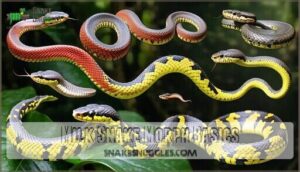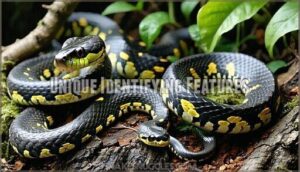This site is supported by our readers. We may earn a commission, at no cost to you, if you purchase through links.

You’ll discover 24-25 recognized subspecies across North and South America, each displaying unique color patterns and morphological traits.
Eastern milk snakes showcase distinctive Y-shaped neck patches, while melanistic varieties like L. t. gaigeae appear almost entirely black.
These non-venomous constrictors mimic dangerous coral snakes through Batesian mimicry – red touches black, you’re safe Jack!
Geographic isolation has created remarkable regional variations in banding patterns, coloration intensity, and scale arrangements.
Understanding subspecies genetics helps you identify authentic morphs versus selectively bred variants.
Popular captive morphs include tangerine, anerythristic, and hypomelanistic phases that amplify natural color variations through careful breeding programs.
Table Of Contents
- Key Takeaways
- Milk Snake Morph Basics
- Top 5 Milk Snake Care Essentials
- Choosing Milk Snake Morphs
- Milk Snake Morph Care Guide
- Frequently Asked Questions (FAQs)
- How many milk snake morphs are there?
- How do you identify a milk snake?
- What is a milk snake?
- What are the different types of milk snakes?
- How can you tell the difference between a milk snake and a Copperhead?
- Are milk snakes nocturnal?
- What is the best setup for a milk snake?
- Are milk snakes good for beginners?
- Can you keep multiple milk snakes together?
- What morph prices range from cheapest to most expensive?
- Conclusion
Key Takeaways
- You’ll find 24-25 recognized subspecies across North and South America, each with distinct color patterns – from Eastern varieties with Y-shaped neck patches to vibrant Central American tricolor bands and melanistic black morphs.
- Proper housing requires a 40-gallon minimum enclosure with temperature gradients of 78-85°F, 40-60% humidity, and aspen substrate for burrowing – these environmental controls are crucial for your snake’s health and displaying optimal morph characteristics.
- You can choose from dozens of captive-bred morphs including tangerine, anerythristic, and hypomelanistic phases, with prices ranging from $50-$150 for common varieties to $300-$800 for rare genetic combinations.
- Never house multiple milk snakes together as they are cannibalistic predators – instead, focus on proper individual care, including pre-killed prey every 5-14 days, depending on age, and maintaining consistent feeding schedules to prevent health issues.
Milk Snake Morph Basics
You’ll discover that milk snakes represent one of nature’s most diverse serpent families, with 24 recognized subspecies spanning from Canada to Ecuador.
Each subspecies displays unique color patterns and morphological adaptations that reflect their specific geographic origins and environmental pressures, making them a fascinating example of diverse species.
Overview of Milk Snake Subspecies
You’ll discover that milk snake subspecies represent one of nature’s most diverse serpent groups, with taxonomists recognizing up to 24 distinct varieties across North and Central America.
These subspecies showcase remarkable adaptations to different environments and climates.
Here are four key subspecies categories you should know:
- Eastern varieties – Feature reddish-brown blotches with black borders on gray backgrounds, common from Maine to Alabama
- Central American types – Include vibrant Honduran and Pueblan subspecies with bold tricolor banding patterns
- Western forms – Sinaloan milk snakes display striking red bands separated by narrow yellow-white stripes
- Specialty morphs – Black milk snakes develop melanistic coloration, transforming from banded juveniles to solid dark adults
Each subspecies exhibits unique color patterns and geographic range adaptations that influence their genetics and identification characteristics. To make certain proper care, understanding snake housing needs is vital for creating a suitable environment.
Geographic Distribution and Habitat
You’ll find milk snakes across an impressive geographic range spanning from Ontario, Canada down to Ecuador.
From Canadian forests to Ecuadorian tropics, milk snakes showcase nature’s remarkable adaptability across diverse ecosystems.
This habitat diversity means you’re dealing with subspecies that have adapted to wildly different environments – from northern woodlands to tropical grasslands and rocky terrains.
Their territorial adaptation skills are remarkable, with each population developing unique traits based on their specific ecological niche and geographic location, showcasing their ability to thrive in various environments with wildly different conditions.
Physical Characteristics and Identification
Through careful examination of milk snake morphs, you’ll identify distinct physical traits that separate subspecies.
Size ranges from 14 inches to over 4 feet, while color patterns vary dramatically across populations.
Key identification features include:
- Color Patterns – Red, black, yellow bands or blotches distinguish subspecies
- Scale Types – Smooth, overlapping scales with triangular head shapes
- Head Shapes – Triangular profile differs from round-headed non-venomous species
- Belly Marks – Distinctive checkered patterns aid in milk snake identification
- Size Variations – Adult length varies substantially between subspecies and morphs
Eastern milk snakes display tan backgrounds with reddish-brown blotches, while Honduran varieties showcase bright red bands.
Mountain forest subspecies transform from banded juveniles to solid black adults, demonstrating remarkable morphological changes.
Behavior, Diet, and Reproduction
Understanding milk snake behavior reveals fascinating insights about their nocturnal hunting tactics and feeding frequency.
These secretive constrictors exhibit remarkable defensive mechanisms, including tail vibration and musk secretion.
Their reproductive cycle spans spring to summer, with females laying 6-24 eggs after elaborate courtship rituals.
Growth patterns show rapid development in hatchlings, reaching maturity within three years through consistent milk snake diet and proper snake feeding habits during milk snake breeding seasons.
To research the health and well-being of milksnakes, it’s vital to investigate their snake care needs and provide appropriate environments.
Top 5 Milk Snake Care Essentials
You’ll need proper equipment to maintain your milk snake’s health and guarantee the best environmental conditions throughout its captive lifespan.
These five essential tools create the foundation for successful husbandry, from temperature regulation to safe handling practices.
1. Reptile Infrared Ceramic Heat Lamp
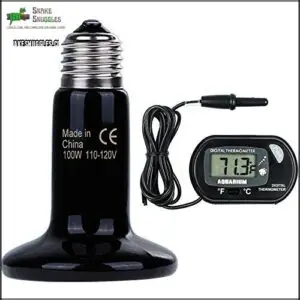
You’ll need proper heat for your milk snake’s health.
Ceramic infrared heat lamps deliver 100% thermal efficiency without light emission, maintaining natural day-night cycles.
These 100W units create essential temperature gradients of 78-85°F that milk snakes require for digestion and thermoregulation.
Position the lamp 10-40cm from your snake using ceramic E27 sockets only—plastic sockets can melt.
Quality ceramic emitters last up to five years with continuous operation, making them cost-effective investments for your terrarium setup, and providing a long-lasting solution with proper heat.
Best For: Pet owners seeking reliable, long-lasting, and light-free heat for reptiles like milk snakes, especially those needing consistent temperature control without sleep disruption.
- Requires a ceramic E27 socket; plastic may melt or explode
- Does not provide UVB or visible light—additional lighting may be needed
- Incorrect placement or wattage can cause overheating or burns
- 100% heat efficiency with zero light, preserves natural day-night cycles
- Long lifespan (up to 5 years), reducing replacement costs
- Maintains ideal basking temperatures for digestion and activity
2. Reptile Large Water Bowl Dish
Every milk snake needs a proper water dish that’s both functional and safe.
You’ll want a large, non-porous bowl made from food-grade resin or ABS plastic that won’t harbor bacteria.
The dish should be wide enough for your snake to curl up inside and deep enough for soaking—about 2-4 inches depending on your snake’s size.
Look for designs with ramped edges to prevent drowning accidents.
Position it on the cool side of the enclosure and change the water daily to maintain proper hygiene and hydration.
Proper snake water bowl recommendations are vital for maintaining excellent snake hydration levels.
Best For: Owners of milk snakes and other medium to large reptiles needing a durable, safe, and easy-to-clean water bowl.
- Heavy, non-porous design resists tipping and prevents bacterial buildup.
- Wide and deep enough for soaking, aiding hydration and shedding.
- Realistic look fits well with any terrarium setup.
- Heavier weight may make daily water changes less convenient.
- Can increase humidity in desert enclosures if not monitored.
- May be oversized for juveniles or smaller species.
3. Reptile Terrarium Humidifier Fog Machine
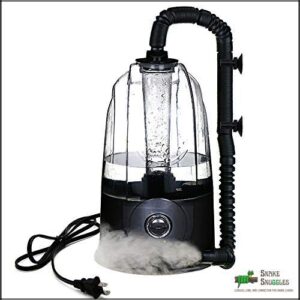
During humid seasons, your milk snake’s respiratory health depends on proper moisture levels.
A reptile terrarium humidifier fog machine maintains the critical 40-60% humidity range milk snakes need for healthy shedding and hydration.
The ultrasonic technology creates fine mist without water accumulation, while adjustable output lets you dial in perfect conditions.
With a 3L tank providing up to 26 hours of runtime, you’ll spend less time monitoring and more time enjoying your serpent companion’s vibrant colors.
Best For: Reptile keepers who want set-and-forget, adjustable humidity control for species like milk snakes with specific hydration needs.
- Adjustable ultrasonic mist output for tailored humidity levels
- Large 3L tank allows up to 26 hours of continuous runtime
- Quiet operation and auto shut-off reduce daily maintenance
- Requires regular cleaning to prevent mold or bacteria buildup
- Overuse can cause overly damp substrate or respiratory issues
- Needs distilled or RO water to avoid mineral deposits
4. Professional Snake Catcher Handling Tool
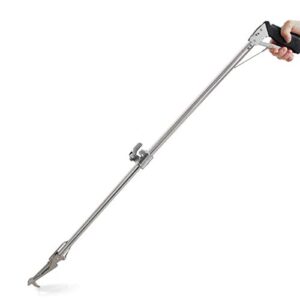
Professional snake tongs revolutionize milk snake handling by creating a safe distance between you and your serpent.
Aircraft-grade stainless steel construction guarantees durability, while serrated jaws provide a secure grip without causing harm.
The automatic lock mechanism keeps snakes contained during relocation or terrarium maintenance, and collapsible designs offer convenient storage, making them perfect for routine husbandry tasks.
You’ll appreciate the soft rubber handles that prevent slipping, even during extended use, as these tools minimize stress for both handler and snake.
Reducing defensive behaviors like tail vibration or musk secretion that milk snakes commonly display is a key benefit of using these tools.
Best For: Professional and hobbyist snake handlers who need a safe, reliable way to manage and relocate milk snakes or other similar species.
- May be heavy and unwieldy for some users, especially longer versions.
- Quality control issues reported, such as loose bolts or rivet concerns.
- Requires careful inspection and proper use to avoid injury to the snake.
- Maintains a safe distance, reducing risk of bites and stress for both handler and snake.
- Durable aircraft-grade stainless steel and collapsible design for easy storage.
- Secure automatic lock and non-slip rubber handles enhance safety and comfort.
5. Reptile and amphibian glass terrarium

Glass terrariums transform your milk snake’s habitat into a crystal-clear showcase while delivering essential environmental control.
You’ll appreciate the watertight construction that maintains proper humidity levels and prevents substrate moisture from escaping.
The dual ventilation system prevents condensation buildup, while front-opening doors make cleaning and feeding effortless.
Choose dimensions matching your snake’s adult length—typically 36x18x18 inches minimum, to create an ideal environment with proper humidity levels.
The raised bottom accommodates under-tank heaters perfectly, creating ideal temperature gradients your milk snake craves.
Best For: Reptile and amphibian keepers seeking a spacious, secure, and easy-to-maintain enclosure for species requiring high humidity and optimal environmental control.
- Heavy and difficult to move once set up
- Does not retain humidity without extra measures like misting or sealing
- Styrofoam background may absorb water and need replacement for some setups
- Excellent ventilation and easy access with front-opening, locking doors
- Raised base and waterproof construction for safe heating and humidity retention
- Durable, scratch-resistant glass providing clear views and enhanced aesthetics
Choosing Milk Snake Morphs
Selecting the right milk snake morph involves understanding each subspecies’ distinct color patterns and geographic origins.
You’ll want to take into account your experience level, available space, and aesthetic preferences when choosing between vibrant tricolor banded varieties like Hondurans or striking melanistic forms like the Black milk snake.
Banded Phase Features and Variations
Banded phase milk snake morphs showcase striking color patterns with 14-20 red rings separated by black borders from yellow bands.
These band variations create tricolor appearances through morph genetics that influence snake markings intensity.
Southern populations display more vivid banded phase features, while phase development varies by subspecies.
Band patterns may break at midlines or form incomplete circles around the body.
Understanding proper snake care and using the right snake care products is essential for maintaining the health and appearance of these unique morphs.
Unique Identifying Features
Several key features help you distinguish milk snake morphs beyond basic color patterns.
Scale texture remains consistent across morphs, but snake markings vary dramatically—some display crisp bands while others show blotched patterns.
Belly scales typically feature distinctive checkered markings that aid identification.
Understanding morph genetics helps predict offspring patterns, making your milk snake identification guide more reliable when selecting specific color morphs.
Tips for Selecting Milk Snake Morphs
Choosing the right milk snake morph requires careful consideration of your experience level and preferences.
Snake genetics influence color patterns and breeding potential, while morph variations affect care requirements and costs.
- Experience Level: Beginners should start with hardy subspecies like Eastern or Sinaloan milk snake morphs before attempting complex breeding projects
- Visual Appeal: Consider whether you prefer vibrant tricolor banding or unique variations like melanistic phases when selecting color patterns
- Long-term Goals: Factor in breeding tips and morph selection strategies if you plan to develop your own milk snake species collection
Understanding the milk snake morph is essential for making informed decisions about your pet.
Where to Find Milk Snake Morphs and Reputable Breeders
MorphMarket leads online directories with over 300 milk snake morphs from verified reptile breeders across North America.
You’ll find breeder reviews and secure transactions through established morph marketplaces like Reptify.
Attend reptile expos for hands-on selection from reputable breeders like Wilbanks Reptiles and BHB Reptiles.
Snake forums provide community recommendations for trusted milk snake breeding operations nationwide.
Milk Snake Morph Care Guide
You’ll discover that proper care transforms your milk snake morph into a thriving companion with specific environmental and dietary needs.
Understanding these requirements guarantees your snake’s health while maximizing the stunning visual traits that make each morph unique, highlighting the importance of proper care for the snake’s overall well-being.
Housing and Environmental Requirements
Your snake enclosure should accommodate their adult size with a 40-gallon minimum for most morphs.
Create a temperature gradient spanning 78-85°F using ceramic heat sources, maintaining humidity levels between 40-60%.
Choose burrowing-friendly substrate options like aspen bedding.
Standard lighting requirements include a day-night cycle, though milk snake habitat doesn’t need UVB lighting like other reptiles.
Proper snake care involves understanding temperature management techniques to guarantee a healthy environment with proper temperature gradient and humidity levels.
Feeding and Health Considerations
With proper housing established, your milk snake’s nutrition becomes the foundation for long-term health.
Diet planning requires understanding your snake’s age-specific needs and feeding frequency requirements.
- Feed juveniles every 5-7 days with appropriately-sized pinkies, shifting adults to 10-14 day schedules
- Monitor prey size carefully – items shouldn’t exceed 1-1.5 times your snake’s midsection width
- Prevent obesity through consistent feeding intervals and body condition assessments
- Watch for feeding refusal indicating stress, shedding cycles, or underlying health risks
- Maintain disease prevention using pre-killed, thawed prey to avoid injuries and parasites
Proper nutrition needs assessment and snake feeding habits directly impact your milk snake’s longevity and vitality.
Understanding snake food options is essential for providing a balanced diet.
Handling and Behavior Tips
Handle your milk snake with confidence using proper snake handling techniques.
Support the body with both hands, avoiding sudden movements that trigger defensive biting.
Wait until your snake settles after feeding before attempting contact.
Keep handling sessions brief to minimize stress, and follow these milk snake care tips to guarantee positive interactions while respecting natural snake behavior patterns.
Breeding and Husbandry Best Practices
Successful milk snake breeding requires careful genetic selection and proper conditioning. You’ll need females at least 3 feet long and well-fed adults before brumation.
Cool them 8-10 weeks at 50-55°F to trigger reproductive cycles. After warming, introduce pairs cautiously—cannibalism risks exist.
Provide nest boxes with moist substrate for egg laying. Maintain incubation temperatures between 78-88°F with high humidity for optimal hatchling development.
To achieve the best results, understanding a snake breeding kit is vital for creating an environment with the right breeding equipment that’s essential for producing healthy offspring.
Frequently Asked Questions (FAQs)
How many milk snake morphs are there?
Currently, no exact count exists for milk snake morphs since breeders continuously develop new variations through selective breeding.
You’ll find dozens of established morphs like albino, anerythristic, and tangerine, with new combinations emerging regularly through captive breeding programs.
How do you identify a milk snake?
Surprisingly, identifying milk snakes involves recognizing their distinctive banded patterns.
You’ll spot red, black, and yellow bands, triangular heads with smooth scales, and checkered belly markings.
Size ranges from 14 inches to over 4 feet depending on subspecies.
What is a milk snake?
A milk snake is a nonvenomous colubrid species native to North and Central America.
You’ll recognize them by their distinctive red, black, and yellow banding patterns that mimic venomous coral snakes for protection.
What are the different types of milk snakes?
You’ll find 24 recognized subspecies across North America, each with distinct appearances.
Popular types include Eastern, Honduran, Sinaloan, and Black milk snakes, featuring varied color patterns from vibrant tricolor bands to solid black morphs.
How can you tell the difference between a milk snake and a Copperhead?
Look for key differences: copperheads have hourglass-shaped crossbands, heat-sensing pits near their eyes, elliptical pupils, and triangular heads.
You’ll notice milk snakes display colorful bands, round pupils, and lack facial pits entirely, which are key distinguishing features from copperheads with heat-sensing pits.
Are milk snakes nocturnal?
Nocturnal behavior varies among subspecies, but you’ll typically find milk snakes most active during dawn and dusk hours.
They’re crepuscular hunters, adapting their activity patterns to local prey availability and temperature conditions, which makes them active during specific times.
What is the best setup for a milk snake?
A 40-gallon enclosure lets your snake stretch comfortably while you maintain 78-85°F temperatures.
You’ll need aspen substrate for burrowing, two hiding spots, and a water bowl.
This setup mimics their natural woodland habitat perfectly.
Are milk snakes good for beginners?
Yes, milk snakes make excellent beginner reptiles.
They’re docile, rarely bite, adapt well to captivity, and don’t require complex care.
You’ll find them forgiving with minor husbandry mistakes while learning proper snake keeping techniques.
Can you keep multiple milk snakes together?
Absolutely never house multiple milk snakes together – they’re cannibalistic predators that’ll literally eat each other! You’d be creating a deadly snake-eat-snake scenario in your terrarium.
What morph prices range from cheapest to most expensive?
Prices typically range from $50-150 for normal morphs, while rare combinations like snow or anerythristic morphs can cost $300-
Breeders determine pricing based on genetics, rarity, and demand for specific color variations.
Conclusion
Mastering milk snake morphs transforms captive care from guesswork into scientific precision.
You’ve discovered how subspecies genetics influence captive breeding success, while proper environmental controls guarantee superior health outcomes.
Your milk snake morph guide knowledge empowers informed decisions about housing requirements, feeding protocols, and handling techniques.
These constrictors reward dedicated keepers with decades of companionship when you apply evidence-based husbandry practices consistently.
- https://www.morphmarket.com/morphpedia/milk-snakes/normal/
- https://www.xyzreptiles.com/milk-snake-care/
- https://articles.pangovet.com/pet-breeds/snakes/types-of-milk-snakes-that-make-great-pets/
- https://www.virginiaherpetologicalsociety.com/reptiles/snakes/eastern-milksnake/index.php
- https://reptilesmagazine.com/honduran-milk-snake-breeding-tips/

